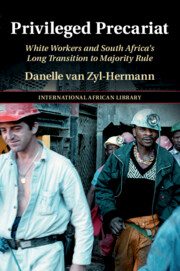Book contents
- Privileged Precariat
- The International African Library
- Privileged Precariat
- Copyright page
- Dedication
- Contents
- Table and figures
- Acknowledgements
- Abbreviations and acronyms
- Introduction
- Part I White workers and the racial state
- Part II White workers and civil society mobilisation
- 4 From trade union to social movement
- 5 An ‘alternative government’
- 6 Discursive labour and strategic contradiction
- 7 ‘Guys like us are left to our own mercy’
- Conclusion
- Bibliography
- General titles
- Newspapers and online sources
- Index
- Series page
6 - Discursive labour and strategic contradiction
Managing the working-class roots of a declassed organisation
from Part II - White workers and civil society mobilisation
Published online by Cambridge University Press: 17 April 2021
- Privileged Precariat
- The International African Library
- Privileged Precariat
- Copyright page
- Dedication
- Contents
- Table and figures
- Acknowledgements
- Abbreviations and acronyms
- Introduction
- Part I White workers and the racial state
- Part II White workers and civil society mobilisation
- 4 From trade union to social movement
- 5 An ‘alternative government’
- 6 Discursive labour and strategic contradiction
- 7 ‘Guys like us are left to our own mercy’
- Conclusion
- Bibliography
- General titles
- Newspapers and online sources
- Index
- Series page
Summary
The previous chapter showed how the Solidarity Movement sought to declass its trade union past in favour of a historical and ideological narrative emphasising Afrikaner cultural unity and the politics of race. Yet profoundly classist attitudes, stereotypes, and prejudice, which contradicted the Movement’s official framing, persisted among its leadership. This chapter uncovers these sub-narratives. It argues that they reveal the discursive labour and strategic contradictions deployed by the Movement’s executives to manage the working-class roots of their organisation and reformulate working-class identity in such a manner as to serve the new social alliance their Movement represents, and to use it as a vehicle for advancing ethnic and racial interests in the wake of the demise of the racial state. This included the leadership’s deployment of class distinctions in terms of education, respectability, political attitudes, and morality to legitimise their own position and agenda. These findings attest to the persistent presence of deep class-based prejudice and tensions within the white population, begging a revision of existing scholarship on post-apartheid Afrikaner identity construction and homogeneous white subjectivities.
Keywords
- Type
- Chapter
- Information
- Privileged PrecariatWhite Workers and South Africa's Long Transition to Majority Rule, pp. 241 - 263Publisher: Cambridge University PressPrint publication year: 2021

